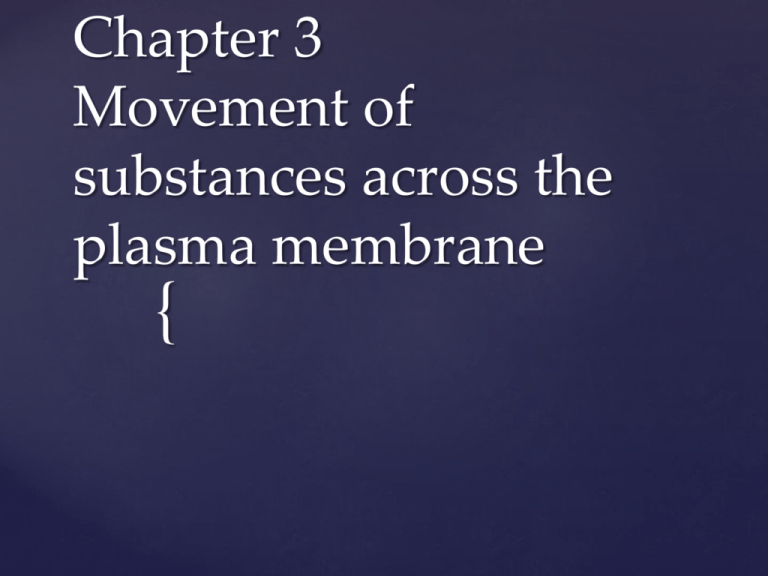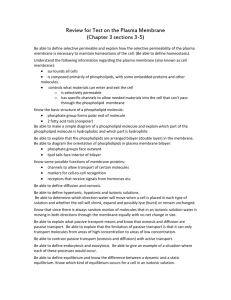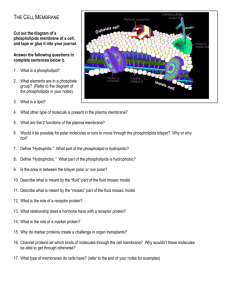Chapter 3 Movement of substances across the
advertisement

Chapter 3
Movement of
substances across the
plasma membrane
{
- Plasma membrane- outstanding features cell
- Its control all the substances which is moving in/
out of the cell
1) What cause of the substances to move in/out? And
how does the plasma membrane control it?
2) Why the water molecule can enter to the cell and
why doesn’t the same thing occurs when its comes
to starch/ protein molecule which is larger?
- In the early of 70s , S.Singer and G.Nicholson did
research on plasma membrane and called it as
‘Fluid Mosaic Model’.
- Plasma membrane consist of phospholipid bilayer,
glycoprotein, protein, carbohydrates chain,
cholesterol molecules , lots of carrier and pore
proteins.
1) Fluid Mosaic Model
Fluid- refer to not rigid/ static but form a dynamic and
flexible structure
Mosaic
- Protein molecules are found embedded/ attached partially
to the surfaces.
- these proteins float about freely on the bilayer to form a
ever changing pattern.
As a conclusion plasma membrane has a fluid
characteristics which allow cell to be more flexible.
a) Does a cell looks like watermelon or 50 cents coins?
-fluid
structure can be move freely and not being rigid.
b) What is rigid?
c) If the cell membrane can move so fluidly, what if too
fluid then can’t support the mass of the cell and
eventually it will burst, right? How the plasma maintain
their structure?
- Researchers found out that, protein structure which are
attached to it, they make stability for plasma membrane.
- Therefore fluid inside the plasma membrane is control by
the protein & other structure that are embedded.
2) Structure of plasma membrane
- Consists of bilayer phosphates (2 layer of lipid) embedded/
attached into them.
a) What are the other things which are attached?
- Proteins (3 different important protein)
- Eg. Glucose molecules comes and attached to the carrier protein,
which will open up and allows the glucose molecule to pass thru
the plasma membrane.
- Pore protein- has very thin pore in between/ smaller version of
pore or hole. This little pores allows ions to move in/ out of the
pore protein.
- Phospholipid bilayer separates both sides of the membrane and
cholesterol attached to the plasma membrane.
- this links fatty acids of the phospholipids, stabilize and
strengthens the cells.
- Cholesterol makes plasma membrane mr flexible and less
permeable to other water soluble substances. Therefore its
creating a semi permeable/ selective permeable. (characteristic of
plasma membrane)
- Glycoprotein act as a part of identity to the cell. Recognize each other
based on protein/ glycoprotein which are attached.
Protein- pore protein [transport small, polar substances such as ions
K+(potassium), Na+(sodium) and Cl- (cloride ions) ]
- carrier protein (transport large, non polar substances such as
amino acids/ glucose)
What is polar?
-known as charged molecules
- In biology, used the term ‘polarity/ polar’
3) Special characterictics of plasma membrane
• selective permeability (Some substances can move across but other
can’t gain entry in to the cells)
• Factor affecting permeability
- Size of molecule
- Polarity of the molecule
Eg. Bacteria trying to attack us, the moment the bacteria gets into our
body, WBC will determine that it’s pathogen and WBC would identify
these would not belong to us based on its protein found in the plasma
4) Phospholipid bilayer
- Consists of head and tail, between the 2 phospholipid
molecules had to be a little gap which is small and
allowing a very small molecules to squeeze to them.
- Consists of reagent known as lipid (fats), therefore
only the same class as lipid could penetrate thru.
- Special molecules (H2O)can pass thru the plasma
membrane.
So water, small lipid molecules (VIP of the cell) that
pass thru without any obstruction.
Why we have 2 layers of phospholipids?
Head - consists of phosphate ions
- hydrophilic
- can dissolve in water
- polar
Tail
- consists of lipids
- hydrophobic
- can’t dissolve in water
- non- polar
Que 1. What are characteristics of phospholipid molecules?
Que 2. Why its called as hydrophilic/ hydrophobic
characteristics?
- 2 phospholipids molecules will clear and push the
water away, so that the tails faced on inside. In that case,
the liquid inside/ outside was separated by the
phospholipid molecules.
ASSESSMENT
1. The current structure of the plasma membrane is
best describe by using the
A. Phospholipid bilayer model
B. Fluid mosaic model
C. S.Singer & G.Nicholson model
D. Plasma membrane of plant cell
2. The main component that make up the plasma
membrane of cell are
A. Protein & carbohydrates
B. Protein & phospholipids
C. Phospholipids & carbohydrates
D. Protein, phospholipids and carbohydrates
3. Which substances can move freely across the phospholipids
of the plasma membrane?
A. Glucose
B. Glyserols
C. Amino acids
D. Ions
4. When only specific substances can move across the plasma
membrane, it is said to be
A. Semi permeable
B. Impermeable
C. Porous
D. Selective diffusion
5. Why is the model used to describe the plasma membrane is
called a ‘Fluid Mosaic Model’?
- The protein molecule and phosphate float laterally and
freely
6. What are the factors that determine the permeability of a
substances?
- Size and polarity of the molecules
7. Why is the phospholipid bilayer of the plasma membrane
arranged opposing each other?
- The characteristic of the phospholipids where head is
hydrophilic and tail to be hydrophobic made to be arranged
opposing each other.
8.The tail of the phospholipid is hydrophobic and its prevent
polar molecules from passing through. Why is water, being a
polar molecule able to pass through the plasma membrane
easily?
- Water could pass through the plasma membrane easily
because water molecule is very small.








